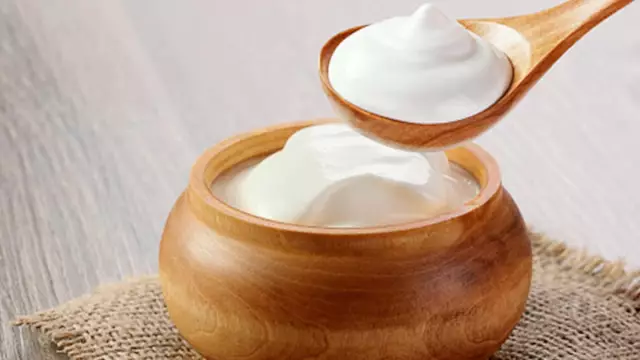- Author Rachel Wainwright [email protected].
- Public 2023-12-15 07:39.
- Last modified 2025-11-02 20:14.
Gouty arthritis
The content of the article:
- Causes and risk factors
- Symptoms of gouty arthritis
- Diagnostics
- Treatment for gouty arthritis
-
Diet for gouty arthritis
Sample menu for gouty arthritis for one day
- Potential consequences and complications
- Forecast
- Prevention
Gouty arthritis (gout) is a joint disease caused by impaired purine metabolism and characterized by the deposition of urates (uric acid crystals) in the joint and periarticular tissues, hyperuricemia (an increase in the concentration of uric acid in the blood). The disease occurs with a frequency of 1 in 1,000 people over 45 years of age. In children and adolescents, gouty arthritis is practically not observed. Men get sick 20 times more often than women. Experts suggest that the low incidence of gouty arthritis among women is associated with the effect of estrogens on the excretion of uric acid. In many cases, the development of gouty arthritis is usually preceded by prolonged (several decades) asymptomatic hyperuricemia.

The clinical picture of gouty arthritis
Causes and risk factors
The most common causes of gouty arthritis are increased production of uric acid (10%) or decreased excretion (90%) of this compound from the patient's body.
Primary overproduction is associated with defects in the enzymatic system of uric acid synthesis. Secondary hyperproduction is due to the accelerated decay of cells during anticancer therapy, chronic hemodialysis, as well as in blood diseases, alcoholism.

The most common cause of gouty arthritis is a decreased excretion of uric acid in the body.
Uric acid excretion disorders are associated with kidney disease (lead nephropathy, chronic renal failure), alcoholism, long-term use of diuretics and / or small doses of acetylsalicylic acid.
Factors that increase your risk of developing gouty arthritis are:
- inaccuracies in diet (abuse of sardines, anchovies, fatty meats, offal, meat extracts, dry wine);
- obesity;
- diabetes;
- lead poisoning;
- long-term therapy with certain drugs (Euphyllin, caffeine, glucocorticoids, cytostatics, diuretics, Diazepam, Diphenhydramine, L-DOPA, dopamine, nicotinic acid, salicylates, vitamins C and group B);
- chronic renal failure;
- hypothyroidism;
- hyper- or hypoparathyroidism;
- hyperlipoproteinemia;
- Paget's disease;
- psoriasis;
- lymphoproliferative diseases;
- sarcoidosis;
- hemolytic anemia;
- hemoglobinopathy;
- Down syndrome.
In the pathological mechanism of the development of gouty arthritis, the main role belongs to long-term hyperuricemia, which causes the deposition of uric acid crystals in the synovial membrane and cartilage, i.e. the formation of microtofuses (accumulations of crystals). Under the influence of provoking factors (a change in the concentration of uric acid in the synovial fluid or blood, an increase in temperature in the joint, joint injury), microtofuses are destroyed and uric acid crystals enter the articular cavity, causing the development of an acute inflammatory reaction.
Symptoms of gouty arthritis
In the clinical course of gouty arthritis, 4 stages are distinguished:
- Asymptomatic hyperuricemia. The content of uric acid in the blood increases in the absence of any clinical symptoms of gouty arthritis.
- Acute gouty arthritis. This stage is the manifestation of the disease. The patient suddenly develops arthritis, accompanied by severe pain. One of the joints of the foot is most often affected. In half of all cases, the first metatarsophalangeal joint is involved in the inflammatory process. Most gouty attacks develop at night. Erythema (redness) and an increase in the local temperature of the skin over the joint, soreness and swelling rapidly increase. With the transition of inflammation to the soft tissues surrounding the joint, phlebitis or cellulitis may develop. With a severe attack, an increase in body temperature is possible. The duration of an attack of acute gouty arthritis is several days. After its completion, the joint takes on a normal shape.
- Interictal period. It starts from the moment the acute arthritis ends and is interrupted by the next acute attack. In 62% of patients, a second attack develops during the first year of the disease, and only 7% of patients do not have a second attack. In the interictal period, patients do not complain. As the disease progresses, each repeated attack becomes more severe, and the duration of the interictal period decreases.
- Chronic gouty arthritis. It represents the final stage of gout. Inflammation affects many joints, that is, polyarthritis develops. At this stage of the disease, patients develop kidney damage (interstitial nephritis, nephrolithiasis).

Degrees of gouty arthritis
Diagnostics
The diagnostic criteria for gouty arthritis are:
- the presence of urate crystals in the synovial fluid;
- tophuses containing crystalline urates.
In addition, the patient must have at least 6 of the following 12 symptoms of gouty arthritis:
- more than one history of acute arthritis attacks;
- manifestations of arthritis, onset, reach a maximum within 24 hours;
- monoarticular nature of the lesion (one joint is inflamed);
- unilateral lesion of the first metatarsophalangeal joint;
- unilateral damage to the joints of the foot;
- swelling and pain in the first metatarsophalangeal joint;
- hyperemia of the skin over the affected joint;
- asymmetric joint swelling;
- suspicion of tophus;
- hyperuricemia;
- subcortical cysts without erosion;
- lack of microflora growth during bacteriological examination of synovial fluid.

The diagnostic criterion for gouty arthritis is the presence of urate crystals in the synovial fluid.
To confirm the diagnosis, instrumental and laboratory examination is carried out, including:
- general blood test (during an acute attack, leukocytosis with a shift of the leukocyte formula to the left, increased ESR);
- biochemical blood test (increased concentration of uric acid in 90% of cases);
- analysis of synovial fluid (the content of leukocytes is 10-60 x 10 9 / l, mainly neutrophils; urate needle crystals);
- radiography (pronounced erosion in the subchondral area of the bone).
Gouty arthritis requires differential diagnosis with a number of other diseases:
- rheumatoid arthritis;
- hyperparathyroidism;
- amyloidosis;
- pseudogout;
- infectious arthritis.
Treatment for gouty arthritis
In an acute attack of gouty arthritis, patients are advised to reduce physical activity and immobilize the affected joint. Colchicine and non-steroidal anti-inflammatory drugs are prescribed to relieve acute inflammation. In severe gouty attacks, intra-articular administration of glucocorticoids is indicated. If the intense pain syndrome cannot be stopped by the listed means, narcotic analgesics can be used.
After the activity of the inflammatory process subsides, patients are prescribed drugs that lower the concentration of uric acid in the blood. In the acute period, their use is contraindicated, since any changes in the concentration of urate in the blood provoke an increase in gouty attack.

Pain syndrome in gouty arthritis is controlled by non-steroidal anti-inflammatory drugs
With the development of chronic tofus gouty arthritis, the use of uricosuric drugs or xanthine oxidase inhibitors is indicated.
Diet for gouty arthritis
In the treatment of the acute phase of gouty arthritis, as well as in order to prevent recurrent exacerbations, patients need nutritional correction. Doctors recommend diet number 6 according to Pevzner for gouty arthritis. Its purpose is to normalize the metabolism of purines, shift the pH of urine to the alkaline side and reduce the synthesis of uric acid and its salts.
Foods rich in oxalic acid and purines are excluded from the diet. Moderately restrict table salt intake. You should also somewhat limit fats (mostly refractory) and proteins, and in the presence of obesity and carbohydrates. Increases the content of foods that promote urine alkalinization (fruits, vegetables, dairy products). In the absence of contraindications on the part of the cardiovascular system, it is recommended to consume at least two liters of free liquid during the day in order to stimulate diuresis and increase the excretion of uric acid.
The chemical composition of the daily diet for gouty arthritis is as follows:
- proteins - 70-80 g (half of them should be represented by vegetable proteins);
- carbohydrates - 400 g (sugar no more than 80 g);
- fats - 80-90 g (35% vegetable oils);
- sodium chloride - 10 g.

With exacerbation of gouty arthritis, diet No. 6 according to Pevzner is recommended
The total calorie content of the daily diet should be 2700-2800 kcal. Food should be taken 4 times a day. Drink plenty of fluids between meals.
The following are completely excluded from the diet:
- mushroom, fish and meat broths;
- dishes from legumes, spinach and sorrel;
- pastry products;
- canned meat and fish;
- salty fish;
- smoked meats;
- sausages;
- meat by-products (brains, liver, kidneys, tongue);
- salty cheeses;
- rhubarb, cabbage;
- figs, raspberries, cranberries;
- chocolate;
- coffee, cocoa;
- mustard, horseradish;
- alcoholic beverages, especially dry wine.
The basis of the diet:
- vegetarian, dairy or fruit soups;
- rye and wheat (from 1st and 2nd grade flour) bread;
- low-fat varieties of meat, fish, poultry (150 g 3 times a week);
- milk and dairy products;
- eggs (no more than 1 piece per day);
- cereals;
- vegetables;
- rosehip broth.
Sample menu for gouty arthritis for one day
First breakfast: salad of fresh vegetables with vegetable oil, pudding of apples, carrots and millet, soft-boiled eggs, weak tea.
Second breakfast: a decoction of dried fruits or rose hips.
Lunch: milk soup with homemade noodles, potato cutlets fried in vegetable oil, jelly.
Afternoon snack: pear or apple.
Dinner: cottage cheese casserole, bell pepper stuffed with rice and vegetables, weak tea with lemon.
At night: oatmeal jelly or a decoction of wheat bran.
Potential consequences and complications
The main complications of gouty arthritis are:
- urate nephropathy;
- chronic renal failure;
- secondary infections.
Forecast
With an early start of therapy, the prognosis is favorable - the symptoms of the disease are completely stopped. When relapses occur, lifelong use of uricosuric drugs or allopurinol is indicated for effective control of uric acid levels. The factors aggravating the prognosis include:
- onset of the disease at a young age (up to 30 years);
- a combination of the disease with urinary tract infections and urolithiasis;
- progression of nephropathy;
- the presence of combined somatic pathology (arterial hypertension, diabetes mellitus).
Prevention
Prevention of gouty arthritis must be carried out in patients with malignant neoplasms. Against the background of chemotherapy, they undergo necrosis and disintegration of tumor cells, which is accompanied by hyperproduction of uric acid, therefore, from the first day of chemotherapy, the appointment of hypouricemic drugs is justified.
To prevent exacerbations of gouty arthritis, you must:
- control body weight;
- observe the water-salt regime;
- adhere to dietary food (table number 6 according to Pevzner);
- engage in physiotherapy exercises;
- give up alcohol and carbonated drinks with sodium benzoate.
YouTube video related to the article:

Elena Minkina Doctor anesthesiologist-resuscitator About the author
Education: graduated from the Tashkent State Medical Institute, specializing in general medicine in 1991. Repeatedly passed refresher courses.
Work experience: anesthesiologist-resuscitator of the city maternity complex, resuscitator of the hemodialysis department.
The information is generalized and provided for informational purposes only. At the first sign of illness, see your doctor. Self-medication is hazardous to health!






